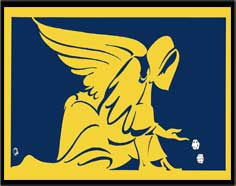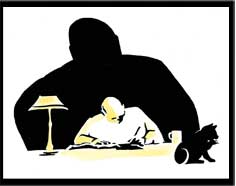During the development of international-style organised crime in Australia throughout the two decades from the mid-1960s to the mid-1980s, a legal loophole was exploited to make Australia a haven for counterfeiters of foreign currency.
It was not until the end of 1985 that special legislation was enacted to make counterfeiting of foreign currency illegal along with forgery of Australian currency.
The absence of any Federal law in the past had been exploited by foreign currency counterfeiters, especially in making millions of dollars worth of fake American banknotes.
It meant that, when counterfeiters of foreign currency had been caught, they had to be proceeded against under common law provisions of State laws.
Proclamation of a new Commonwealth Crimes (Currency) Act at last provided for the same penalty for counterfeiting either foreign or domestic currency — 14 years’ jail or a fine of $75,000.
At the time of Federation in 1901, the Australian States ceded to the Commonwealth the exclusive right to legislate in regard to currency. It did so for Australian currency but overlooked to include foreign currency.
The oversight was first highlighted with the establishment in 1929 of an international convention for the Suppression of Counterfeiting Currency.
The principal objective of the convention has been to encourage all countries to avoid having lesser penalties for counterfeiting foreign currency than for their own domestic currencies.
Though a participant nation, sending delegates when convention countries have met every eight years, Australia had been in the embarrassing position of being forced to apologise for not having any national law against either making, passing or exporting counterfeit foreign currency.
A police authority on counterfeiting, Vic Anderson, who headed a Federal police currency squad before becoming director of the Australian Bureau of Criminal Intelligence and later an Assistant Commissioner of the Federal police, took up the issue after representing Australia at a convention. He noted that even though Australian banks had suffered greatly at the hands of counterfeiters in Europe and Asia where Australian currency had been forged and distributed, Australian authorities had failed to act. His point: ‘Public confidence in the nation’s currency is of paramount importance, as is the confidence of overseas governments in the currency of Australia.’
Legislation to ratify convention requirements was finally put through parliament in 1981 but not proclaimed until October 1985. The delay had been despite the fact that the flaw in Australian law had attracted international media attention 18 years earlier during Australia’s most celebrated foreign currency counterfeiting case.
An American citizen, Robert Baudin, who had spent eight months in a US prison for counterfeiting millions of dollars worth of petrol coupons, came to Australia in 1948 ostensibly to set up an aerial photography business.
During the 1950s, he printed fake American banknotes on an offset press in a room of a home in the Sydney suburb of Balmain. In one recorded excursion, he sold counterfeits with a face value of more than $50,000 to agents in Spain and Italy.
In 1968, notes from a batch of $US100,000 he had left in a metal box with a friend who had accompanied him to Australia, Richard Pratt, began surfacing in America and Germany.
In all, Baudin was alleged to have printed up to $US10 million worth.
Among batches of various denominations of American notes and printing plates seized when Baudin was arrested were experimental plates of an Australian 10 pound note, superseded by the introduction of decimal currency.
In a bizarre episode after his arrest, Baudin buzzed Sydney in a light aircraft, threatening to crash the plane while he bargained by radio with the then NSW Commissioner of Police, Norman Allan, over what charges he would face.
The commissioner agreed, with a memorable radio message: ‘Romeo Charlie Alpha — your conditions are agreed to and you are cleared to land.’ It meant that Baudin was only charged with forging an Australian 10 pound note — and not in connection with any of the foreign currency. Baudin was jailed for 14 months.
In a book called Fake, published overseas in 1977, Baudin disclosed that he knew his ground because ‘somewhere I’d read that owing to a weakness in Australian law little could be done about the manufacture of foreign bills — provided none had been circulated in Australia’.
It was Baudin’s book that inspired Australia’s biggest counterfeit operating involving domestic currency.
Melbourne solicitor Blair Forsyth, sentenced to jail in November 1985 with two other men over a scheme to manufacture counterfeit $50 notes at a Bendigo factory, was said in court to have used Baudin’s book as a guide.
Since the original Baudin case, there have numerous other examples of counterfeit syndicates exploiting the delay in bringing down Federal legislation.
When the world’s biggest seizure of counterfeit American dollars occurred in Melbourne in 1974, investigators had to resort to State common law charges.
Forged American $20 notes totalling nearly $US12 million were seized. In the absence of Federal law, ringleaders of the counterfeit syndicate were charged under the Victorian Crimes Act.
The charge boiled down to ‘conspiracy to make and distribute counterfeit United States of America banknotes, thereby effecting a public mischief.
No doubt exploiting the lack of Federal law, counterfeiters in Australian until now have tended to concentrate more on foreign rather than domestic currency.
In the 1974 case, a counterfeiting syndicate used Melbourne as a base to make the forged American banknotes for distribution not in Australia but in Europe and Asia.
The scheme came unstuck when two distributors, Roger Gilbert and Alan Wray, were arrested in Zurich, Switzerland, in January 1974, trying to pass some of the counterfeit $US20 notes. A search of their hotel room disclosed 5000 of the notes.
When police interviewed associates of Gilbert, it was found that Gilbert had confided that he was going overseas on an undisclosed mission for a syndicate but had been assured it was not illegal.
Inquiries led to John Maxwell Singer, a Melbourne identity since scrutinised by the Costigan Royal Commission over involvement in international arms deals.
Police recovered counterfeit notes with a face value of $US11,842,360, including $US140,000 handed over by Singer in Thailand. Most of the fakes were seized from a bank vault, a transport company and a house in Melbourne.
Although nominated as a ‘foundation’ member of the syndicate, Singer gained indemnity to testify against other syndicate members.
A wealthy Toorak company director, Charles Zuker, financier of the counterfeit operation, was sentenced to five years’ jail. A painter, Nick Kypraios, the printer, received three years. An architect, Stephen Kyriakidis, the alleged organiser, absconded on bail.
Printing plates used in the counterfeiting were later found embedded in two concrete blocks dumped in the Yarra River, near Abbotsford Bridge. Of the $US12 million known to have been printed, fakes with a face value of $157,640 were never traced.
Counterfeit American $20 notes (as well as $100 notes) were also seized in Queensland in 1976 after a police diving team came across dumped printing plates while searching for stolen motor vehicle number plates.
Manufactured in Victoria, the plate material was traced to the Brisbane office of a company called Offshore Research and Development. In the printing process, a thumb print was left on one of the plates. It matched that of the company’s managing director, Charles Hope.
At his office, police found a Gestetner offset lithographic printing press, along with batches of counterfeit notes. Another suitcase full was handed over to police by the Queensland manager of Gestetner, George Blacklock. A friend of Hope, Blacklock told police that Hope had asked him to take care of the locked case until he sorted out his affairs.
Hope was charged with forgery under the Queensland Criminal Code. But he then had himself admitted as a voluntary psychiatric patient, thus preventing police interviewing him further.
A backyard printing operation raided in the Sydney suburb of Peakhurst in 1980 was found to be the hub of a sophisticated international counterfeit network involving both $100 and $20 US notes.
Federal police smashed the Australian end of the network after receiving a tip-off while investigating links between Australian and American organised crime identities.
Fake notes with a face value of nearly one million dollars American were located in Australia. But by the time police had arrested Australian members of the syndicate, and confiscated a printing press, large numbers of the fakes had been laundered through banks in Honolulu, Manila, Hong Kong and Sydney.
Counterfeit English pound notes have been used by criminals associated with international shoplifting gangs trained in Australia.
In one episode, in 1976, two men were arrested after using counterfeit 10 pound Sterling notes to shout rounds of drinks for a restaurant full of strangers at Kings Cross.
Since they had passed some of the money, they were charged under NSW law with ‘uttering a forged document’.
One of the men, John Cunningham, from Britain, had previously also used two counterfeit bank cheques to buy jewellery in Melbourne.
Neither Cunningham nor his associate, William Mair, from Sydney, would disclose the whereabouts of the printing set-up.
A new type of counterfeit West German 100 deutschmark note was first detected in Sydney. Later, similar fakes were found in Melbourne and in West Germany. The printing operation was traced to Sydney and the NSW north coast town of Coffs Harbour. Four Australians were arrested.
American banknotes have proved to be the most fre-quently counterfeited currency in the world, mainly because the American dollar is accepted anywhere, making it perhaps the world’s only truly international currency. American dollar notes are also vulnerable because all denominations are the same size, with only two colors — black and green.
In contrast, Australian notes vary in size for each denomination, and feature a variety of colors. They also incorporate a high quality three dimensional watermark and a security thread.
This means that fakes can be more easily spotted. A note can be checked simply by placing a thin sheet of paper over it, then gently rubbing over it with a pencil. With a genuine note, this will bring up the outline of the watermark and security thread.
from Connections 2 by Bob Bottom





